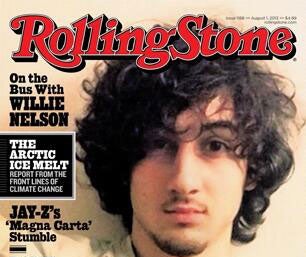Boston suspect Dzhokhar Tsarnaev and Rolling Stone: Cover stars don’t have to be heroes
That this image of Tsarnaev has been in the papers is neither here nor there

The brouhaha about the Rolling Stone cover featuring Boston bombing suspect Dzhokhar Tsarnaev underlines how people have come to regard an appearance on a magazine cover as an automatic endorsement.
Boston city council president Stephen Murphy accused the magazine of “marketing Tsarnaev as a hero”. Actually, there’s nothing particularly heroic about the picture, the kind of “selfie” that any averagely narcissistic young dude can drum up nowadays.
The heroism is something the magazine format itself lends to any subject it places in its frame, which is why musicians, actors, sports stars and even politicians hire PRs to “get them the cover” (and nothing less), and at the same time to exert as much control over the tone of the picture as they can. What Murphy is reacting against is Tsarnaev’s appearance on the same cover that did so much to canonise stars such as Bruce Springsteen, Madonna and Bono as well as those whose celebrity followed them beyond the grave. Jim Morrison was celebrated with the cover line “He’s hot, he’s sexy, he’s dead”.
The fact that the same image of Tsarnaev has appeared in respectable newspapers is neither here nor there. He’s not in the cover. He’s on it. He’s Rolling Stone’s brand, its point of sale, its fleeting message to the moron in a hurry who, according to magazine lore, picks up a magazine on impulse. He’s also clearly identified as guilty via a cover line that wouldn’t get past the subs in the UK.
An old head like myself remembers the days when Rolling Stone was the Life magazine of the Woodstock generation. In those days it was no great surprise to see someone like Charles Manson on the cover, as he was in 1969. For today’s readers, who are more used to Taylor Swift and Jessica Alba, a visual style closer to Elle than Oz and ads for male grooming products rather than smoking paraphernalia, Tsarnaev will come as a shock, which will certainly hurt Rolling Stone in the short term. Some chains will pull the issue from the stands; a few advertisers will withdraw their business, but the magazine’s owner Jann Wenner may reckon it’s worth it to put a bit of rebel lustre back on his 50-year-old brand.
I spoke to Andy Cowles, the British art director who worked on Rolling Stone in the early 2000s. He defended what they did but not how they did it. “It’s a legitimate thing to have done, but by using a colour picture rather than black and white and letting the image run over the logo, they’ve lost the critical distance they needed.” (Andy has provided an example of what he would have done on his blog at http://coverthink.com). Such tiny details make all the difference.
Twitter: @davidhepworth

Join our commenting forum
Join thought-provoking conversations, follow other Independent readers and see their replies